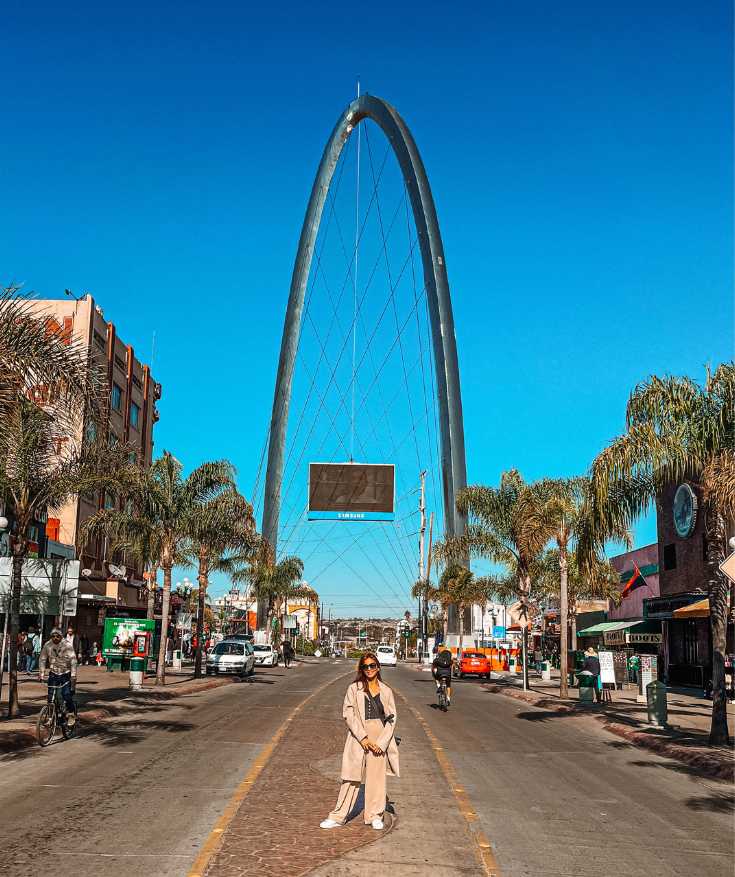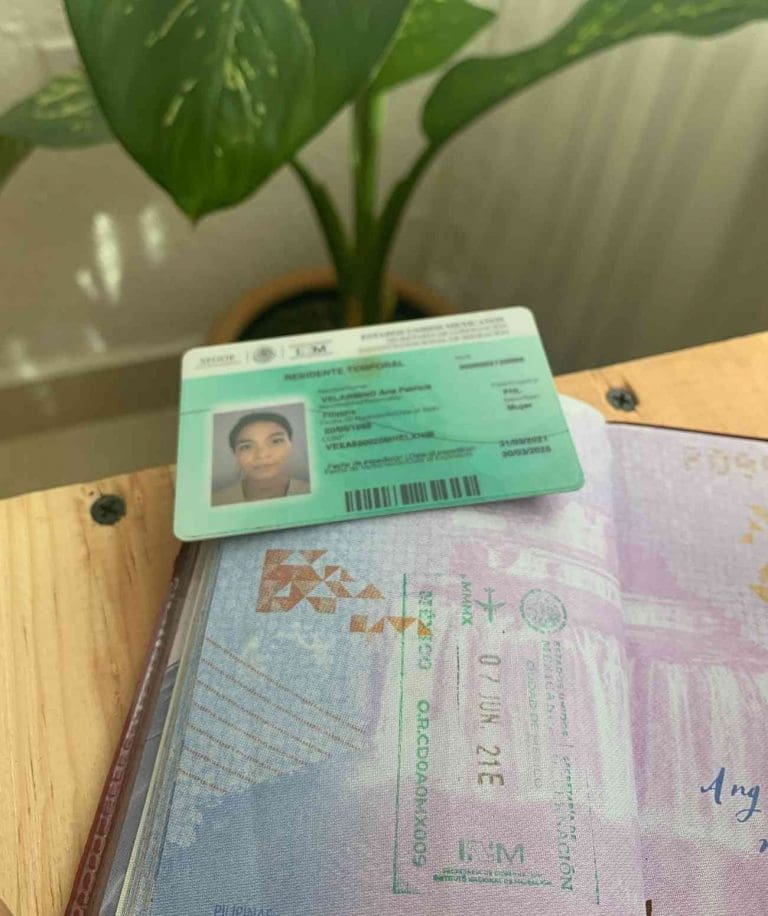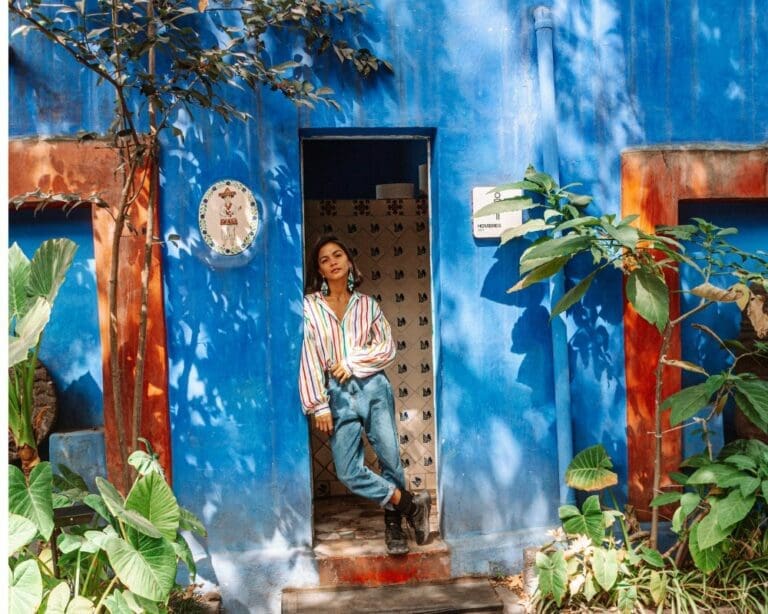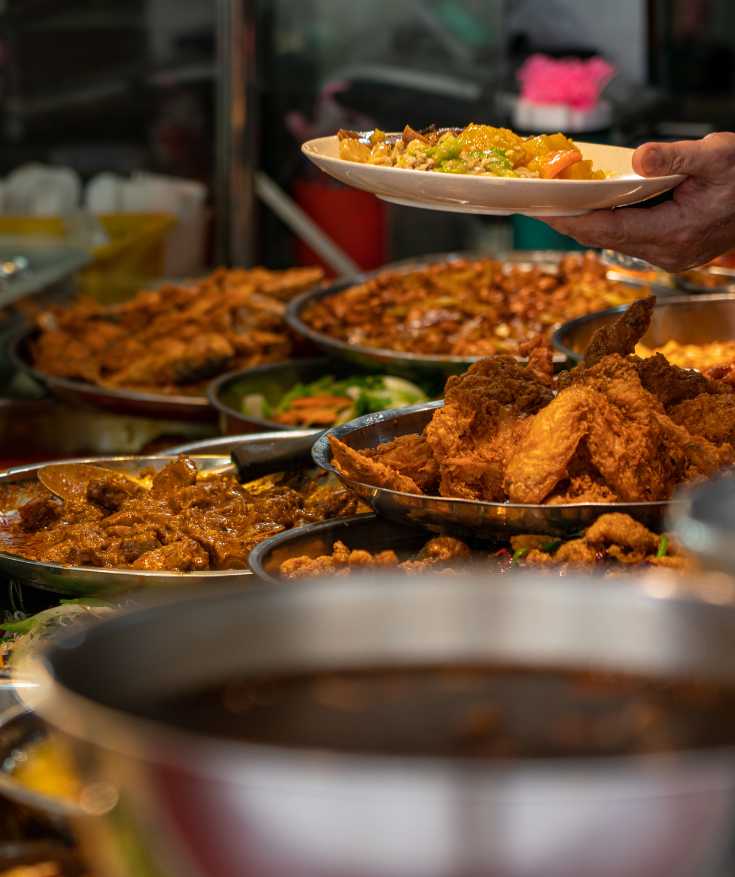40 Mexican food you should try for your trip to Mexico: the fantastic cuisine that everybody loves
👋 Hola! My name is Trisha, and one of the reasons why I decided to live in Mexico is Mexican food! Everybody loves it, and any nationality knows what Mexican cuisine is. It’s simply hard to say no to Mexican food!
Mexican cuisine is an incredibly rich and diverse gastronomy that has evolved over the centuries. It’s a unique mix of flavors, ingredients, spices, and cooking styles passed down through generations, and it continues to surprise and delight with its variety.
The main staples of most meals in Mexican cuisine include corn-based dishes such as tortillas, quesadillas, tamales, and enchiladas; these all use various types of corn masa combined with different fillings to create delicious dishes.

Beans are also eaten often; either refried or served in soups or stews. Fish is a popular ingredient in coastal areas while beef, chicken, pork and lamb are found more inland.
Seasonings vary depending upon the region but generally involve chilies such as jalapeños or chipotles to add flavor and cumin for extra spice. Onions, garlic, tomatoes, and limes are commonly used too for additional flavor. Herbs like cilantro and oregano provide aromatics, while sour cream is used to balance out spicier dishes.
Mexican cuisine encapsulates centuries of culinary traditions that make it one of the most exciting cuisines in the world! This guide will take you through all the Mexican food you must try while traveling here.
🙋 Questions about Mexican food? Ask me on Tiktok!


🔗 Mexican food: quick links
- Mexican food tours: 100+ food tours in Mexico
- Best cities for food adventures: Mexico City | Oaxaca City
- Unique Mexican food destination: Puebla
🌮 Popular Mexican food
Tacos
Tacos, a quintessential Mexican dish, are simple yet flavorful, consisting of a folded or rolled tortilla filled with various ingredients. Typically, corn tortillas are used, but flour tortillas are also common, especially in northern Mexico.
Fillings range from seasoned meats, like carne asada (grilled beef), al pastor (marinated pork), and barbacoa (slow-cooked meat), to vegetables, seafood, or cheese. The meats are often marinated in a blend of spices and herbs, then grilled or slow-cooked to tender perfection.


Toppings such as onions, cilantro, tomatoes, and avocado add texture and freshness, while salsas of varying heat levels contribute depth of flavor. Lime wedges are often served alongside for a citrusy accent.
Tacos can be found at street food stands, known as “taquerias,” or in restaurants all over Mexico, each region boasting its own distinct style. In Mexico City, tacos al pastor, served with pineapple, are particularly popular, while in Baja California, tacos de pescado (fish tacos) reign supreme.
Mole
Mole is a rich and complex blend of ingredients that creates a unique flavor profile. Mole has pre-Hispanic roots, and its most famous variation, mole poblano, hails from Puebla.
With over 20 ingredients, mole combines the flavors of chilies, spices, fruits, nuts, and chocolate to create a harmonious and distinctive taste.


The key ingredients in mole are dried chilies, such as ancho, pasilla, and mulato, which lend a smoky, spicy flavor. These chilies are combined with spices like cinnamon, cloves, and cumin, as well as fruits like tomatoes, plantains, or raisins, adding sweetness and depth.
Nuts and seeds, like almonds, peanuts, and sesame seeds, contribute to the sauce’s thick texture. However, the defining element of mole is chocolate, which balances the flavors and adds a subtle richness.
Making mole is labor-intensive, requiring time and patience to toast, grind, and simmer the ingredients. Despite its complexity, mole is a beloved dish in Mexico and a symbol of its diverse culinary heritage.
Tostadas
Tostadas are popular Mexican foods consisting of a crispy, fried, or baked corn tortilla topped with various ingredients. “Tostada” means “toasted” in Spanish, referring to cooking the tortilla until it reaches a golden, crunchy texture.
Tostadas provide a versatile base for an array of flavorful toppings and are enjoyed throughout Mexico, with regional variations reflecting local culinary preferences.
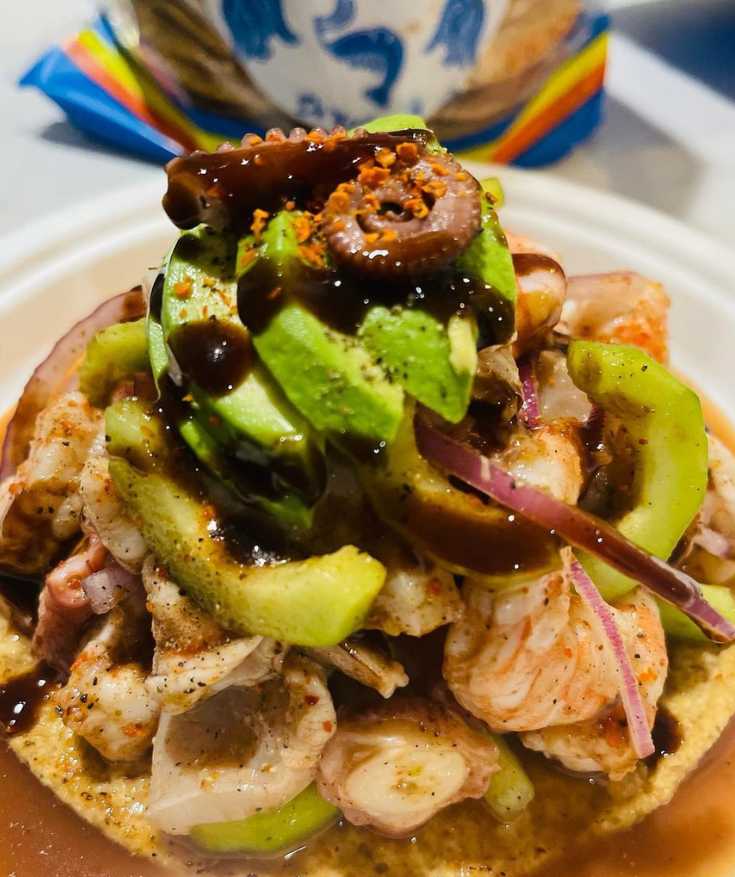

The foundation of a tostada is a flat, round corn tortilla, which is either deep-fried or oven-baked to achieve its signature crispness. Tostadas can be topped with various ingredients, such as refried beans, shredded lettuce or cabbage, diced tomatoes, onions, avocado, and crumbled cheese, like queso fresco or cotija.
Proteins like shredded chicken, beef, or pork and seafood options like ceviche or shrimp can also be added. To finish, tostadas are often garnished with sour cream, salsa, or guacamole, adding a touch of creaminess and spice.
Tostadas can be found in street food stalls, casual eateries, and restaurants across Mexico, offering a satisfying crunch and a delightful combination of flavors and textures.
Guacamole
Guacamole is a traditional Mexican dip made primarily from ripe avocados, known for its creamy texture and vibrant green color. The name “guacamole” originates from the Nahuatl word “ahuacamolli,” which translates to “avocado sauce.”
With ancient roots dating back to the Aztecs, guacamole has been enjoyed in Mexico for centuries and is now popular worldwide as a versatile condiment or appetizer.
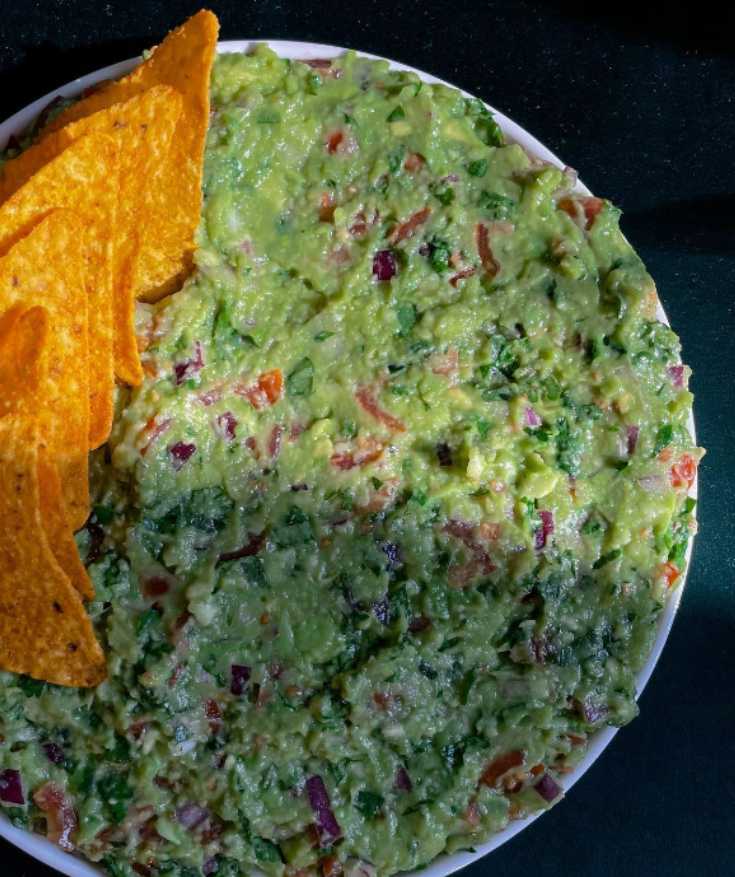

The key ingredient in guacamole is ripe avocados, which provide a rich, buttery base. To make guacamole, the avocados are mashed or puréed, creating a smooth or chunky texture depending on personal preference.
Traditional guacamole recipes include diced tomatoes, finely chopped onions, cilantro, jalapeño or serrano peppers, and lime juice. The lime juice adds a tangy flavor and prevents the avocado from browning due to oxidation. Seasonings like salt, garlic, and cumin may also be added to enhance the taste.
Guacamole is typically served as a dip with tortilla chips, but its uses extend far beyond that. It can be a topping for tacos, tostadas, and burritos, or an accompaniment to grilled meats and fish.
Tortilla
A tortilla, an essential component of Mexican cuisine, is a thin, round flatbread made from either corn or wheat flour. Tortillas have been a staple in Mesoamerican diets for thousands of years, and today, they continue to play a vital role in Mexican culinary traditions.
They serve as a versatile base for various dishes, from tacos and enchiladas to chilaquiles and quesadillas.
Corn tortillas, the more traditional variety, are made from masa, a dough created by mixing ground nixtamalized corn (hominy) with water. The nixtamalization process involves soaking and cooking corn kernels in an alkaline solution, which improves the corn’s nutritional value and allows for easier grinding.


The resulting masa is pressed into thin, round disks and cooked on a hot griddle or comal until slightly puffed and speckled with brown spots.
Flour tortillas from northern Mexico combine wheat flour, water, salt, and a fat, such as lard or vegetable shortening. The dough is kneaded, divided into small balls, and rolled into thin circles before being cooked on a griddle.
Both corn and flour tortillas are enjoyed throughout Mexico and have been adopted by various regional and fusion cuisines worldwide.
Quesadilla
Quesadilla, a popular Mexican dish, consists of a tortilla filled with cheese and other ingredients, then folded in half and cooked until the cheese melts and the tortilla turns golden and crisp.
“Quesadilla” is derived from the Spanish word “queso,” meaning cheese. Quesadillas are known for their simplicity and versatility, making them a beloved comfort food in Mexico and beyond.
Traditionally, quesadillas are made with corn tortillas, although flour tortillas are also widely used, particularly in northern Mexico and international adaptations of the dish.
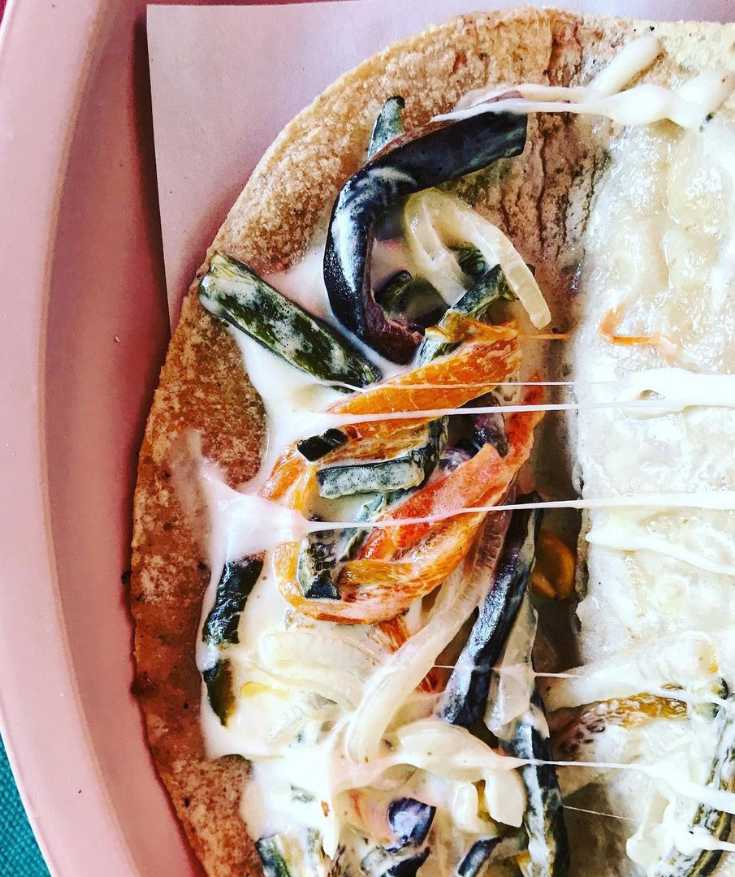

Quesadillas can be customized with additional fillings, including cooked meats like shredded chicken, beef, or pork, and vegetables like sautéed onions, peppers, mushrooms, or zucchini blossoms.
Quesadillas can be cooked on a griddle, comal, or skillet, and in some regions, they are deep-fried for a crispy, indulgent texture. Once cooked, they are often served with condiments like salsa, guacamole, or sour cream, adding flavor and creaminess.
From street food stalls to family kitchens, quesadillas are a ubiquitous and comforting presence in Mexican cuisine. Their simplicity, adaptability, and satisfying taste make them a favorite across cultures and borders.
Burritos
Burritos are a popular Mexican dish consisting of a large flour tortilla filled with various ingredients, then rolled into a cylindrical shape and often grilled or steamed to seal the edges.
The word “burrito” translates to “little donkey” in Spanish, possibly alluding to the dish’s portability or the rolled bundles carried by donkeys.
The base of a burrito is a large, pliable flour tortilla, which is used to wrap and contain the fillings. Burritos can be filled with a wide range of ingredients, including seasoned meats such as carne asada (grilled beef), carnitas (slow-cooked pork), or barbacoa (slow-cooked beef or lamb).


Other common fillings are rice, beans (refried or whole), cheese, lettuce, tomatoes, onions, and avocado or guacamole. Regional variations may include seafood, potatoes, or scrambled eggs.
In Tex-Mex and Mexican-American cuisine, burritos are often larger and more elaborate, incorporating additional ingredients like sour cream, salsa, and jalapeños. These “loaded” burritos sometimes come smothered in a chili or cheese sauce.
Though their origins are modest, burritos have become an international culinary sensation, offering a customizable and portable meal that showcases Mexican and Mexican-influenced cuisine’s diverse flavors and ingredients.
Carnitas
Carnitas, a beloved Mexican dish, refers to tender, slow-cooked pork that is shredded and often crisped before serving. The term “carnitas” translates to “little meats” in Spanish, highlighting the dish’s characteristic succulent, bite-sized pieces.
Carnitas are traditionally made using a whole pork shoulder or a combination of cuts, including fattier portions to ensure a moist and flavorful result. The pork is seasoned with a simple blend of salt, garlic, and sometimes citrus, then slow-cooked in a large pot or copper cauldron filled with lard or oil.
This cooking method, known as “confit,” allows the meat to become tender and fall-apart over several hours, while the fat helps to seal in the flavors.


Once cooked, the carnitas are typically shredded and then crisped up on a griddle or in a hot oven to create a delightful contrast of textures: moist, tender meat with crispy, caramelized edges.
Carnitas are commonly served as a filling for tacos, burritos, or tortas, accompanied by toppings like diced onions, cilantro, salsa, and lime wedges.
Carnitas showcase the rich, satisfying flavors of Mexican cuisine, offering a mouthwatering combination of textures that has earned the dish a devoted following around the world.
Flautas
Flautas, a popular Mexican food, are rolled tortillas filled with various ingredients and then deep-fried to achieve a crispy, golden exterior.
The name “flauta” means “flute” in Spanish, a reference to the dish’s elongated, cylindrical shape. Flautas are enjoyed throughout Mexico, with regional variations reflecting local culinary preferences and traditions.
Flautas can be made with either corn or flour tortillas, although corn tortillas are more traditional. The tortillas are first softened to make them pliable for rolling.
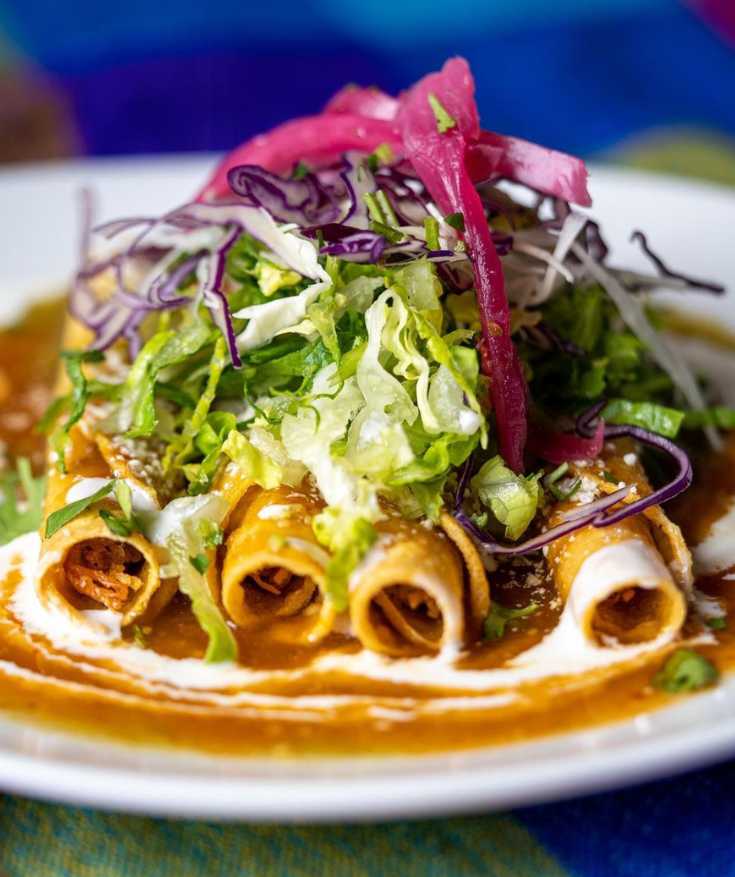

They are then filled with ingredients such as shredded or ground meats like chicken, beef, pork, beans, or cheese. After being tightly rolled around the filling, the flautas are secured with a toothpick to keep their shape during frying.
The flautas are deep-fried until they develop a crunchy, golden-brown exterior, contrasting with the tender, flavorful filling. Once cooked, the toothpicks are removed, and the flautas are typically served in groups of three or four, accompanied by various toppings and garnishes.
Common accompaniments include shredded lettuce or cabbage, diced tomatoes, crumbled cheese, sour cream, guacamole, and salsa.
Fajitas
Fajitas, a dish originating in the Mexican-American culinary tradition, consists of grilled meats and vegetables served on a sizzling platter, often accompanied by warm tortillas and an assortment of toppings.
The term “fajita” is derived from the Spanish word “faja,” meaning “belt” or “girdle,” which refers to the skirt steak originally used for this dish. Fajitas have gained popularity both in Mexico and internationally for their interactive, customizable nature and bold flavors.
Fajitas typically feature strips of marinated meat, such as beef (usually skirt or flank steak), chicken, or shrimp, grilled alongside sliced bell peppers and onions.


The marinade often includes lime juice, garlic, chili powder, and cumin, infusing the meat with a zesty, smoky flavor. The dish is known for its sizzling presentation, with the cooked ingredients brought to the table on a hot cast-iron skillet or platter.
Accompaniments for fajitas include warm flour or corn tortillas, sour cream, shredded cheese, guacamole, and salsa or pico de gallo. Diners can assemble their fajita-filled tortillas, customizing them to their taste preferences.
Though not a traditional Mexican dish, fajitas have become a beloved part of Tex-Mex and Mexican-American cuisine, offering a festive, flavorful dining experience that encourages sharing and interaction.
Chile Relleno
This classic Mexican dish is a staple in many households and restaurants nationwide. It’s made by stuffing a roasted poblano pepper with cheese or meat, then dipping it in egg batter and frying it until golden brown.


The result? A crispy, cheesy, and slightly spicy delight that will leave you wanting more. The origins of this delicious dish date back to the 16th century when Spanish colonizers introduced peppers to Mexico.
Poblanos quickly became popular due to their versatility and mild heat level. Today, chile rellenos can be found on almost every Mexican restaurant menu throughout the world, but there’s nothing quite like trying it in its birthplace – Mexico!
Mexican Salsa
When it comes to Mexican cuisine, nothing is quite as iconic as salsa. This delicious condiment has been a staple in Mexican kitchens for centuries, and with good reason!
One of the things that make Mexican salsa so special is its versatility. It can be used as a dip for chips or veggies, added to tacos and burritos for extra flavor, or even used as a marinade for meats.


And with so many different types of salsas available – from classic tomato-based versions to fruity variations made with mango or pineapple – there’s always something new to try.
Of course, no discussion of Mexican salsa would be complete without mentioning the heat factor.
☕ Support this blog’s honest and transparent journalism. Help us add value to what we are sharing. Keep P.S. I’m On My Way free for all by donating to our coffee fund.
🍳 Mexico food for breakfast
Enchiladas
Enchiladas, a classic Mexican dish, consist of corn tortillas filled with various ingredients, rolled up, and then smothered in a flavorful sauce before being baked.
The term “enchilada” comes from the Spanish word “enchilar,” meaning “to season with chili,” reflecting the dish’s chili-based sauce. Enchiladas are enjoyed throughout Mexico, with regional variations showcasing the diverse flavors and ingredients of the country’s culinary heritage.
The foundation of enchiladas is corn tortillas, which are filled with an array of ingredients such as shredded or ground meats, cheese, beans, or vegetables. Once filled and rolled, the enchiladas are placed seam-side down in a baking dish.
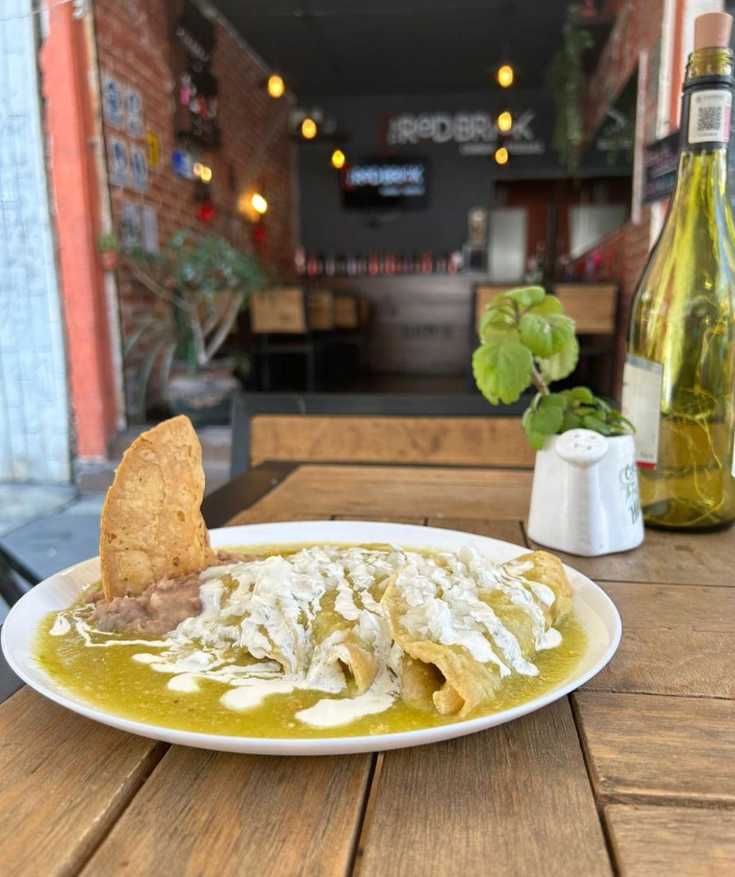

The dish’s defining feature is the sauce that covers the enchiladas, which can be made from various types of chilies, tomatoes, or tomatillos, depending on the specific recipe.
Some well-known variations include enchiladas rojas (red enchiladas), enchiladas verdes (green enchiladas), and enchiladas suizas (Swiss-style enchiladas with a creamy sauce).
After being covered in sauce, the enchiladas are typically topped with cheese and baked until heated through and the cheese is melted and bubbly. Enchiladas are often garnished with additional toppings such as sliced onions, chopped cilantro, sour cream, or avocado.
Chilaquiles
Chilaquiles, a traditional Mexican dish, feature fried corn tortilla pieces simmered in a sauce, resulting in a satisfying, hearty meal often enjoyed for breakfast or brunch.
The name “chilaquiles” is derived from the Nahuatl words “chilli” (chile) and “aquilitl” (torn apart), which describe the dish’s key components. Chilaquiles are celebrated for their comforting texture and bold flavors, making them a beloved staple in Mexican cuisine.
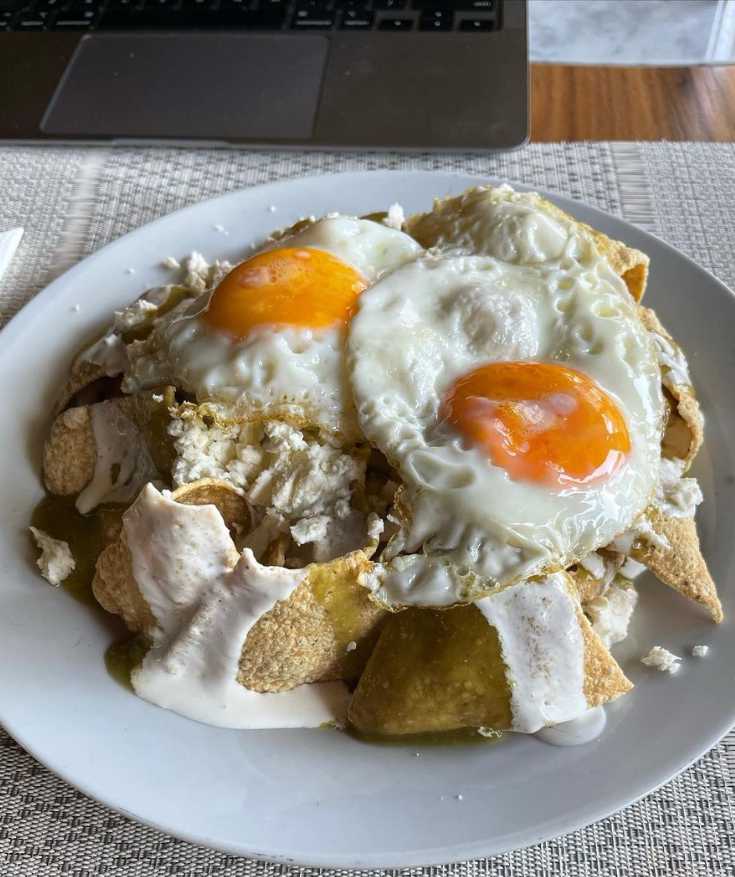

These fried tortilla pieces are then simmered in a sauce, which can be either red (made from dried red chilies or tomatoes) or green (made from tomatillos and green chilies), depending on regional and personal preferences. As the tortilla pieces absorb the sauce, they soften and take on the sauce’s robust flavors.
Chilaquiles are often topped with various ingredients, such as shredded chicken, fried or scrambled eggs, crumbled queso fresco or cotija cheese, diced onions, sliced avocado, and chopped cilantro. A dollop of sour cream or crema may also be added for a touch of creaminess.
Chilaquiles provide a delicious and satisfying way to repurpose leftover tortillas, showcasing the resourcefulness and creativity of Mexican culinary traditions while offering a flavorful, comforting meal.
Machaca
Machaca, a traditional Mexican dish, is made from slow-cooked, shredded, and seasoned beef or pork that is then typically pan-fried with various ingredients.
Originating in the northern states of Mexico, machaca is known for its robust, savory flavors and satisfying, tender texture. The dish has its roots in preserving meat by drying and pounding it, allowing it to be stored and transported more easily.
Machaca is prepared by slow-cooking meat, such as beef brisket or pork shoulder, until it becomes tender enough to be easily shredded. The shredded meat is then seasoned with a blend of spices, such as garlic, cumin, and chili powder.


Traditionally, the meat would be sun-dried and pounded into flakes to preserve it, but modern versions often skip this step.
To serve, the seasoned shredded meat is pan-fried with various ingredients like onions, bell peppers, tomatoes, and sometimes scrambled eggs. This creates a flavorful and hearty mixture that can be enjoyed in various ways.
Machaca showcases Mexican cuisine’s resourcefulness and rich flavors, offering a versatile and satisfying dish that has become a beloved staple in both traditional and contemporary culinary contexts.
Mollete
Mollete, a popular Mexican dish, consists of a sliced, open-faced bolillo or telera roll topped with refried beans, melted cheese, and various other ingredients.
Molletes are known for their simplicity, satisfying flavors, and versatility, making them a beloved comfort food in Mexico. Often enjoyed for breakfast or as a snack, molletes can be found in homes, street food stalls, and restaurants nationwide.
The base of a mollete is a bolillo or telera roll, which are types of Mexican white bread rolls similar to French baguettes but shorter and wider. The roll is sliced in half lengthwise and toasted, creating a warm and slightly crispy surface.
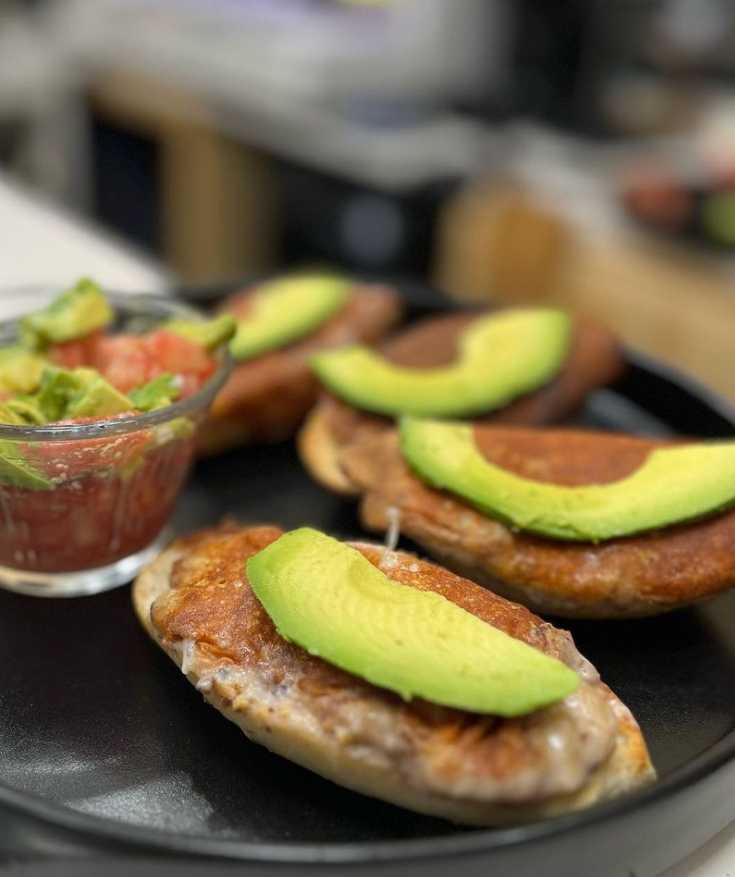

After the beans are spread, the mollete is topped with shredded or sliced cheese, typically a mild and meltable variety such as Oaxaca, Chihuahua, or Monterey Jack. The molletes are then broiled or baked until the cheese is melted and bubbly, creating a delectable contrast of textures and flavors.
Molletes can be customized with additional toppings, such as pico de gallo, sliced avocado, crumbled chorizo, or pickled jalapeños. These versatile open-faced sandwiches showcase Mexican cuisine’s comforting and flavorful qualities, offering a delicious and adaptable meal for any time of day.
Huevos Divorciados
Huevos divorciados, which translates to “divorced eggs” in Spanish, is a popular Mexican breakfast dish featuring two fried eggs served on corn tortillas, each topped with a different sauce.
The dish’s playful name stems from separating the two eggs by their distinct sauces, with one egg covered in a red sauce and the other in a green sauce, representing a culinary “divorce.”
The red sauce, or salsa roja, is typically made from tomatoes, dried red chilies, garlic, and onion, while the green sauce, or salsa verde, is made from tomatillos, green chilies, garlic, and onion.


The contrast between the two sauces provides a delightful balance of flavors, with the red sauce offering a warm, smoky taste and the green sauce delivering a tangy, zesty kick.
In addition to the eggs and sauces, huevos divorciados are commonly served with a side of refried beans and garnished with fresh toppings, such as sliced avocado, chopped cilantro, crumbled queso fresco, or a sprinkle of diced onion.
Some variations also place a strip of fried, crispy bacon or a row of thinly sliced jalapeños between the two eggs, further emphasizing the separation.
Huevos divorciados showcase Mexican cuisine’s creativity and playful spirit, offering a visually appealing and flavorfully diverse breakfast dish that has become a beloved morning staple.
Huevos Rancheros
Huevos rancheros, a classic Mexican breakfast dish, consists of fried eggs served on warm corn tortillas and topped with a savory tomato-chili sauce.
“Huevos rancheros” translates to “rancher’s eggs” in Spanish, reflecting the dish’s rural origins as a hearty, filling meal enjoyed by farmers and ranchers. Its combination of simple, flavorful ingredients has made it a beloved staple of Mexican cuisine and a popular breakfast choice worldwide.


The foundation of huevos rancheros is corn tortillas, which are warmed and then topped with fried eggs. The eggs are typically cooked sunny-side up or over-easy, allowing the rich, runny yolk to mix with the dish’s other components.
The eggs and tortillas are then smothered in a tomato-chili sauce, which can range in spiciness and complexity depending on the recipe. The sauce is usually made from tomatoes, onions, garlic, and either fresh or dried chilies, creating a warm, smoky, and slightly tangy flavor profile.
Huevos rancheros can be served with various accompaniments, such as refried beans, sliced avocado, crumbled queso fresco, or a sprinkle of chopped cilantro. Some variations include additional ingredients like chorizo, potatoes, or sautéed vegetables.
Huevos a La Mexicana
“A la Mexicana” is a term used in Mexican cuisine to describe a dish prepared with the colors of the Mexican flag, which are green, white, and red.
These colors are achieved by incorporating specific ingredients that add a visually appealing aspect and contribute a delightful blend of flavors. Dishes prepared “a la Mexicana” typically include fresh and simple ingredients, showcasing the vibrant flavors of Mexican culinary traditions.
The key ingredients to achieve the “a la Mexicana” style are green chilies (jalapeños or serranos), white onions, and red tomatoes. These ingredients are often sautéed or used as a base for various dishes, creating a colorful and flavorful foundation.
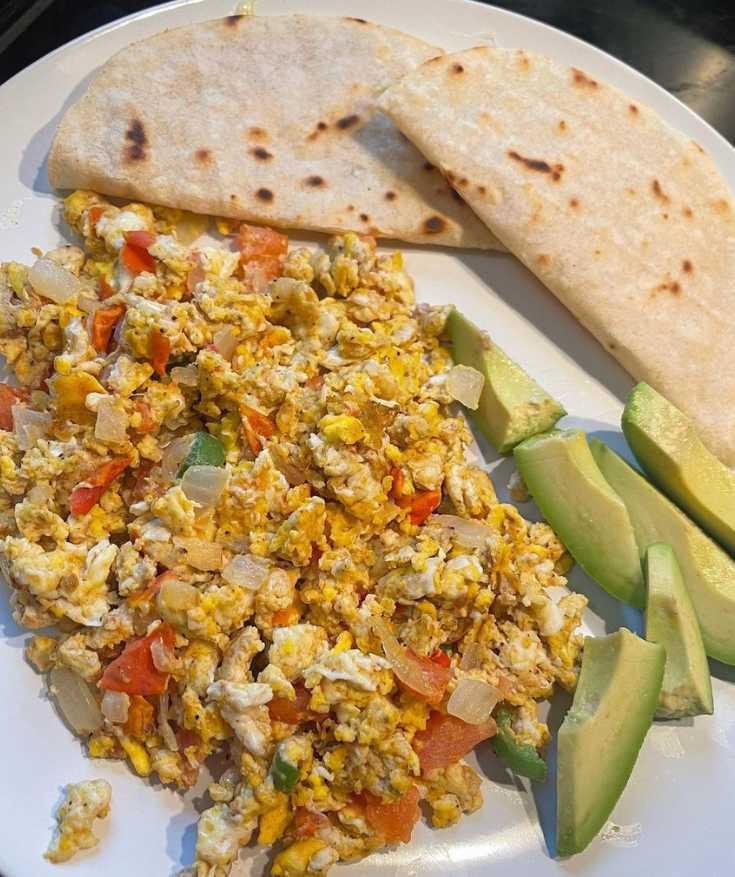

Combining these ingredients results in a mildly spicy, sweet, and tangy taste that adds depth and character to the dish.
Dishes that can be prepared “a la Mexicana” include scrambled eggs (huevos a la Mexicana), sautéed shrimp (camarones a la Mexicana), and various meat dishes, such as chicken or beef cooked with the tricolor ingredients. These dishes are typically served with warm corn tortillas and a side of refried beans or rice.
The “a la Mexicana” style celebrates the essence of Mexican cuisine, emphasizing fresh, colorful, and flavorful ingredients that create a visually stunning and delicious meal experience.
Torta
A torta, in the context of Mexican cuisine, refers to a hearty, flavorful sandwich made with a variety of fillings and served on a crusty white bread roll called a bolillo or telera.
Tortas are a popular choice for lunch or a quick meal in Mexico, enjoyed at home, street food stalls, and restaurants for their satisfying and customizable nature. The dish showcases the versatility and bold flavors of Mexican culinary traditions.
Before assembling the sandwich, the bread is often spread with a layer of refried beans, mayonnaise, or avocado, providing a creamy base that enhances the overall taste and texture.


Tortas can be filled with various ingredients, such as grilled or fried meats (chicken, beef, or pork), chorizo, eggs, cheese, or even breaded and fried cutlets (milanesa).
The sandwiches are typically garnished with additional toppings like shredded lettuce or cabbage, sliced tomatoes, onions, jalapeños, and pickled vegetables, which add extra layers of flavor and texture.
The Mexican torta offers a delectable combination of flavors and textures, making it a beloved and versatile choice for those seeking a satisfying, portable, and customizable meal.
I customize Mexico tours! 🎉🥳
I live in Mexico and have traveled to all 32 states of Mexico. You can call or send a Whatsapp to my office at +52 473 171 5259 to get a quote: no hidden costs, just simple prices
🦞 Mexico foods: seafood dishes
Ceviche
Ceviche, a popular dish in Mexico and throughout Latin America, consists of raw fish or seafood marinated in citrus juice, typically lime, and combined with fresh, vibrant ingredients.
The dish is celebrated for its refreshing and zesty flavors, making it an ideal choice for warm weather or as a light appetizer. Ceviche showcases the freshness and diversity of seafood available in the coastal regions of Mexico, as well as the country’s bold culinary traditions.
The lime juice’s acidity alters the seafood’s proteins, changing its texture and color, resulting in a firm, opaque appearance similar to cooked fish. This process imparts a tangy, refreshing taste to the seafood.


Depending on regional and personal preferences, Ceviche can be made with various types of fish or seafood, such as shrimp, scallops, or squid.
In addition to the citrus-marinated seafood, ceviche typically includes ingredients like diced tomatoes, onions, jalapeños or serrano chilies, and chopped cilantro. Some Mexican variations also incorporate diced avocado or cucumber for added creaminess or crunch.
Ceviche is served chilled, often with tortilla chips or tostadas for scooping and garnished with additional lime wedges. This light and flavorful dish highlight Mexican cuisine’s fresh, bold tastes, offering a delightful and invigorating meal experience.
Aguachile
Aguachile, a traditional Mexican dish originating from the coastal regions of Sinaloa and Nayarit, is a variation of ceviche that features raw seafood marinated in a spicy, tangy, and herbaceous green sauce.
The name “aguachile” translates to “chili water” in Spanish, reflecting the dish’s characteristic blend of chilies, lime juice, and water. Aguachile is celebrated for its bold, refreshing flavors and is typically enjoyed as a light appetizer or snack, especially in the warmer months.
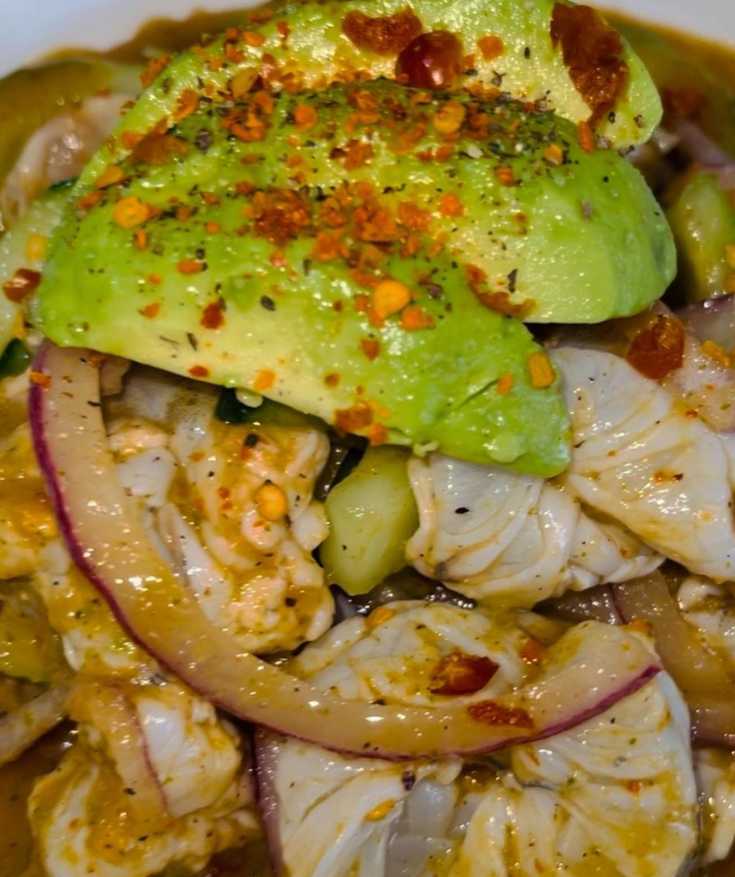

The seafood is then marinated in a vibrant green sauce made from a blend of lime juice, green chilies (such as jalapeños or serranos), cilantro, and water, which imparts a tangy, spicy, and herbaceous taste to the dish.
Like ceviche, the acidity of the lime juice “cooks” the seafood through a process called denaturation, changing its texture and color to resemble cooked fish or shrimp.
Aguachile is typically served chilled, accompanied by thinly sliced red onion, cucumber, and sometimes avocado for added freshness and texture. The dish is often enjoyed with tortilla chips or tostadas for scooping.
Aguachile showcases Mexican coastal cuisine’s vibrant, bold flavors, offering a delicious and invigorating meal experience.
Camarones al Coco
Camarones al coco, or coconut shrimp, is a popular dish in Mexico, particularly in the coastal regions where seafood is abundant.
The dish features succulent shrimp coated in a coconut-flavored batter and breadcrumbs, which are then fried until crispy and golden brown. Camarones al coco is celebrated for its delightful contrast of textures and flavors, combining coconut’s sweetness with shrimp’s tender juiciness.


To prepare camarones al coco, shrimp are first peeled, deveined, and butterflied, leaving the tail intact for presentation. The shrimp are then dipped in a batter made from flour, cornstarch, and coconut milk, imparting a subtle coconut flavor.
After being coated in the batter, the shrimp are dredged in a combination of breadcrumbs and shredded coconut, creating a crunchy, textured exterior that will become crispy when fried. The shrimp are then deep-fried in hot oil until they reach a golden-brown color, and the coconut coating is crispy.
Camarones al coco can be served as an appetizer or main course, often accompanied by a dipping sauce, such as a sweet-and-sour or a sweet-spicy mango or pineapple sauce, which complements the dish’s flavors and adds an extra layer of complexity.
Baja-style fish tacos
Baja-style fish tacos are a popular and iconic Mexican dish from the Baja California region, extending along Mexico’s Pacific coast. Known for their fresh, crispy, and flavorful profile, Baja-style fish tacos showcase the area’s abundant seafood and embody the essence of coastal Mexican cuisine.
The main ingredient in Baja-style fish tacos is mild white fish, such as cod, halibut, or mahi-mahi, sliced into manageable portions. The fish is coated in a seasoned batter made from flour, cornstarch, and a carbonated liquid like beer or sparkling water.
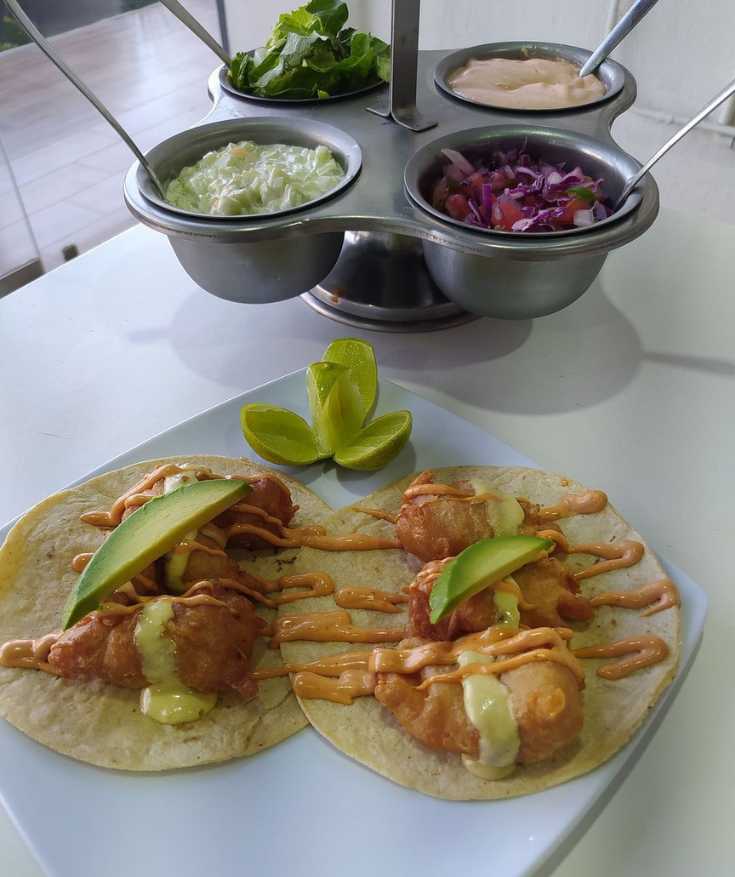

The fried fish is placed on a warm corn tortilla to assemble the taco, which serves as the dish’s foundation. The taco is topped with fresh, crunchy ingredients, such as shredded cabbage, diced tomatoes, and thinly sliced onions.
A tangy, creamy sauce, often made from mayonnaise, sour cream, or yogurt mixed with lime juice and spices, is drizzled over the top, adding a layer of flavor and moisture.
Baja-style fish tacos are typically served with a wedge of lime for an extra burst of citrus. This delicious and satisfying dish highlights Mexican coastal cuisine’s fresh, bold, and diverse flavors.
Pescado de Zarandeado
Zarandeado is a traditional Mexican dish from the coastal states of Sinaloa and Nayarit, where fresh seafood is abundant. The dish features a whole fish, typically a snapper or sea bass, marinated in a flavorful mixture of spices and citrus, then grilled to perfection.
Zarandeado showcases Mexican coastal cuisine’s rich and diverse flavors, offering a delicious and satisfying meal.


To prepare zarandeado, a whole fish is cleaned, scaled, and butterflied, leaving the head and tail intact. The fish is then marinated in a mixture of spices, such as garlic, oregano, and paprika, along with citrus juices, like lime or orange, which impart a tangy and zesty flavor.
After marinating, the fish is placed on a grill or cooked over an open flame, often using a metal grilling basket or a split-open barrel called a “zaranda” (from which the dish gets its name).
The fish is cooked slowly, allowing the flavors to develop and the fish to become tender and flaky. During grilling, the fish is frequently basted with the remaining marinade to keep it moist and enhance the flavors.
Zarandeado is traditionally served with warm corn tortillas, rice, or grilled vegetables, along with a selection of salsas and garnishes, such as lime wedges, chopped cilantro, and sliced avocado. This delectable dish highlights Mexican coastal cuisine’s fresh, bold tastes and vibrant colors.
🍲 Mexico foods: soups
Sopa de Tortilla
Sopa de tortilla, also known as tortilla soup, is a traditional and comforting Mexican dish with a rich and flavorful broth, garnished with crispy tortilla strips and a variety of toppings.
This dish highlights the essential flavors of Mexican cuisine and is popular across the country, with regional variations reflecting local ingredients and preferences.
At its core, sopa de tortilla features a flavorful broth made from tomatoes, onions, garlic, and chilies, such as pasilla, ancho, or guajillo.
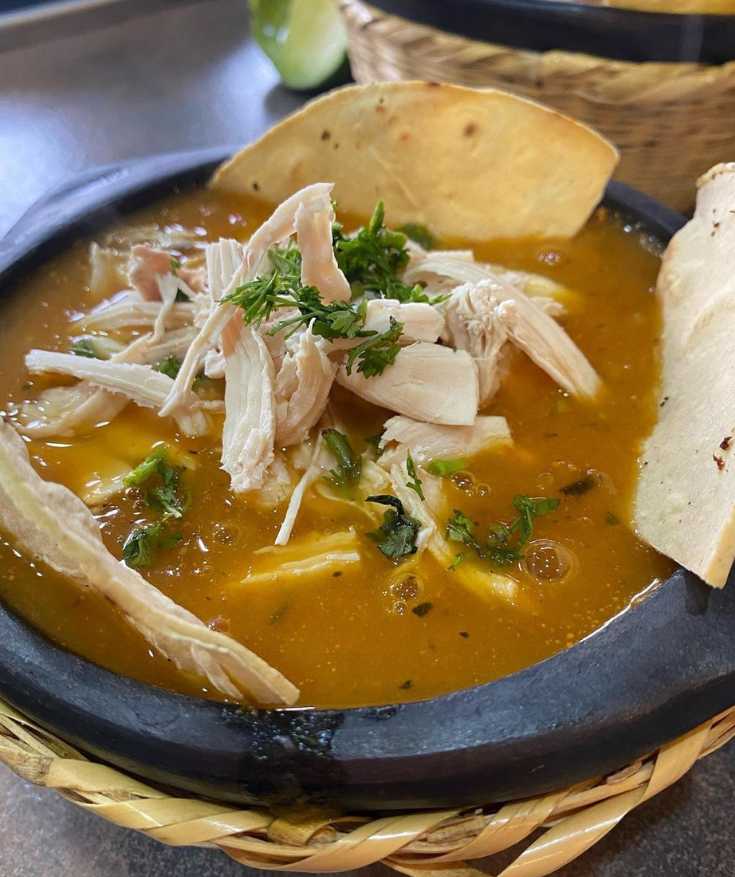

The broth is seasoned with spices like cumin, oregano, and epazote, an aromatic Mexican herb. Chicken or vegetable stock is used as a base, giving the soup depth and richness.
Corn tortillas are cut into thin strips and fried to create the iconic tortilla element until crispy and golden brown. These crunchy strips are added to the soup or served as a garnish. When served, the tortilla strips soak up the flavorful broth, providing a delightful contrast of textures.
Sopa de tortilla is typically garnished with fresh toppings, such as sliced avocado, crumbled queso fresco or cotija cheese, chopped cilantro, diced onion, and a dollop of sour cream. Some versions also include shredded chicken or roasted corn for added heartiness.
Sopa azteca
This tasty soup is filled with layers of flavor that will leave you wanting more. Made with fresh ingredients and spices, it’s the perfect way to warm up on a chilly day.
Sopa azteca, or tortilla soup, is a classic dish originating in Mexico. It’s made by simmering chicken broth with tomato puree, garlic, onions, and chili peppers.
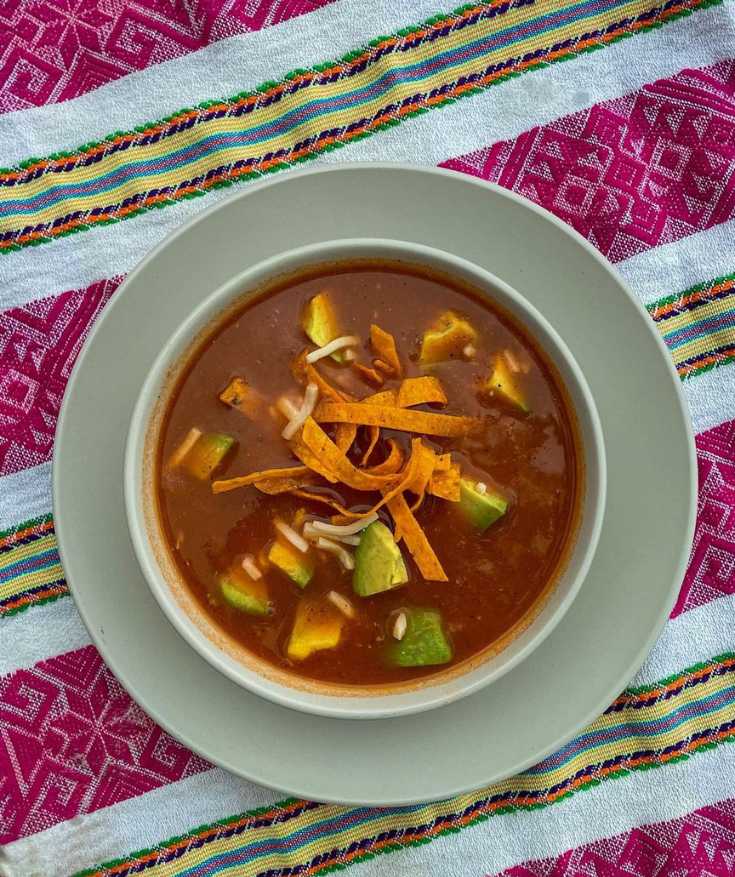

The soup is then seasoned with cumin, oregano, and other spices before being topped off with crispy corn tortillas strips. Garnished with fresh cilantro leaves and slices of avocado or lime wedges for added zestiness.
This soup is packed full of nutrients and protein from the chicken broth while being low in calories due to its vegetable base.
Sopa de Lima
Sopa de lima is a classic Mexican dish perfect for those who love soup and zesty flavors. It’s a simple yet delicious recipe that consists of chicken, vegetables, and lime juice. The unique taste of this soup comes from the tangy lime flavor that complements the savory broth perfectly.
To make sopa de lima, you’ll need some basic ingredients such as shredded chicken, onions, garlic, tomatoes, and of course limes!


The first step is to sauté the onions and garlic until they’re soft and fragrant. Then add the tomatoes and let them cook down before adding your chicken broth. Once everything has simmered together nicely, it’s time to add in the shredded chicken and lime juice.
The result is a hearty soup that’s full of flavor thanks to its combination of spices and fresh ingredients.
🎊 Mexican food for special occasions
Tamales
Tamales, a staple in Mexican cuisine, are made from masa (corn dough) filled with various ingredients, wrapped in corn husks or banana leaves, and then steamed to perfection.
They have a rich history dating back to the pre-Columbian era and were consumed by ancient civilizations like the Aztecs and Mayans as a portable, nourishing meal.
The tamales’ foundation is masa, created by mixing ground nixtamalized corn with lard or vegetable shortening and water or broth, resulting in a soft, pliable dough.
Fillings include seasoned meats like chicken, pork, beef, vegetables, beans, or cheese. Sweet tamales, filled with fruits, nuts, or chocolate, are also popular.


Once filled, the masa is spread onto a softened corn husk or banana leaf, then folded to encase the filling. The wrapped tamales are placed upright in a steamer and cooked until the masa firms up and separate easily from the husk or leaf.
Tamales are enjoyed throughout Mexico and vary by region, with specific ingredients and wrapping techniques reflecting local culinary traditions.
They are often served during special occasions and holidays, such as Christmas, Day of the Dead, and Las Posadas. Tamales are a symbol of Mexico’s rich cultural heritage and culinary diversity.
Chile en Nogada
Chile en Nogada is a traditional Mexican dish that originates in the state of Puebla. It is a stuffed pepper dish made using poblano peppers filled with ground meat, fruits, spices, and herbs.
The stuffed chilies are then topped with a creamy walnut-based sauce called “Nogada,” which is traditionally white in color. Finally, they are garnished with pomegranate seeds, parsley or cilantro leaves, adding extra flavor to the already delectable dish.


This dish is often served during the Mexican Independence Day celebrations in September when the ingredients are fresh and in season.
Chile en Nogada is also considered a representation of the Mexican flag, as the red pomegranate, the white walnut sauce, and the green herbs create the flag’s colors.
Cochinita Pibil
Cochinita Pibil is a traditional Mexican dish which originated in the Yucatan Peninsula. It is a slow-roasted pork dish marinated in a special mixture of achiote paste, citrus juices, and spices before being cooked in banana leaves.
The marinade infuses the pork with smoky and tangy flavors, while the banana leaves help to keep the meat moist and tender. The dish is often served with pickled onions, fresh cilantro and lime wedges, and can be enjoyed on its own or in tacos, burritos, or tortas.


Traditionally, Cochinita Pibil was cooked in a pit oven, which gave it a unique smoky flavor. However, nowadays, it is often prepared in modern ovens or slow cookers, making it more accessible to home cooks.
Cochinita Pibil is an integral part of the Yucatecan cuisine and is often served during special occasions such as weddings, baptisms, or other family celebrations.
Pozole
Pozole is a traditional Mexican dish that has been enjoyed for centuries. This delicious soup-like stew is made with hominy, meat (usually pork), and a blend of spices that give it its signature flavor.
It’s often served during special occasions like holidays or family gatherings, but it’s so tasty that you’ll want to make it any time of the year!
One thing that sets pozole apart from other soups and stews is its unique texture. The hominy gives it a slightly chewy bite that adds depth to every spoonful.


But let’s not forget about the toppings! Toppings are an essential part of any pozole experience, and they can vary depending on where you are in Mexico or personal preference.
Some popular toppings include shredded cabbage, diced onion, fresh lime juice, sliced radishes, and chopped cilantro.
🍢 Iconic Mexico foods on the street
Tlayudas
If you’re planning a trip to Mexico, there’s one dish that you absolutely cannot miss: tlayuda. This delicious and hearty meal is one of Mexico’s most famous street foods, and it’s easy to see why. Tlayudas are essentially large, crispy tortillas loaded with all sorts of tasty toppings.


Traditionally, tlayudas are made with a layer of refried beans on top of the tortilla, followed by your choice of meat (usually beef or pork), fresh vegetables like lettuce and tomatoes, and plenty of cheese.
Some variations even include avocado or salsa for an extra kick! The finished product is grilled until the cheese is melted and bubbly – yum! One thing that sets tlayudas apart from other Mexican dishes is their size.
Esquites
Esquites are one of Mexico’s most beloved street foods. This delicious snack is made from tender, juicy corn kernels cooked until they’re lightly browned and then mixed with a variety of seasonings and toppings.


The result is a dish bursting with flavor and texture, making it the perfect choice for anyone looking for a tasty treat on the go. The history of esquites dates back to pre-Columbian times when the Aztecs used to roast maize kernels in clay pots over an open fire.
They would then grind the roasted kernels into flour to make tortillas or mix them with other ingredients to create dishes like tamales and atole. Today, these little cups of heaven can be found on almost every street corner throughout Mexico City and beyond.
Elotes
Elotes, a popular Mexican street food, has been enjoyed by locals and visitors alike for decades. This savory snack is made from boiled or grilled corn-on-the-cob that is coated with various condiments such as lime juice, chili powder, salt, mayonnaise and cotija cheese.


The tradition of elotes can be traced back to pre-Columbian times when indigenous Mexicans used maize in their daily diet. Different names throughout Mexico know elotes; in the Yucatan Peninsula, they are called “esquites” while in the north they are referred to as “eloteros”.
Today’s modern version of elotes can be found on nearly every corner in bustling cities such as Mexico City and Guadalajara. It is a convenient snack that can be eaten on the go or enjoyed with friends at a local street vendor’s cart.
Tlacoyo
Tlacoyo is one of the most popular street foods in Mexico, and it’s not hard to see why. These delicious snacks are made with blue corn masa and stuffed with a variety of fillings before being grilled to perfection. But where did tlacoyos come from, and what makes them so special?


Believe it or not, tlacoyos can be traced back over 7,000 years to the ancient civilization of Mesoamerica. They were originally made with a mixture of beans and corn dough and were an important part of the diet for many indigenous peoples in Mexico. Over time, they evolved into the tasty treats we know today.
One of the things that sets tlacoyos apart from other Mexican foods is their unique shape. They’re long and thin like a canoe, making them easy to hold and eat.
Gorditas
Gorditas are a staple in Mexican cuisine and have a history that dates back to pre-Columbian times. These delicious little pockets of goodness are made from corn masa dough and traditionally filled with beans, cheese, or meat. The name “gordita” literally means “little fat one,” referring to their plump shape.
Back in the day, gorditas were often served as a quick snack for farmers working in the fields. They were easy to make and could be filled with whatever ingredients were on hand.
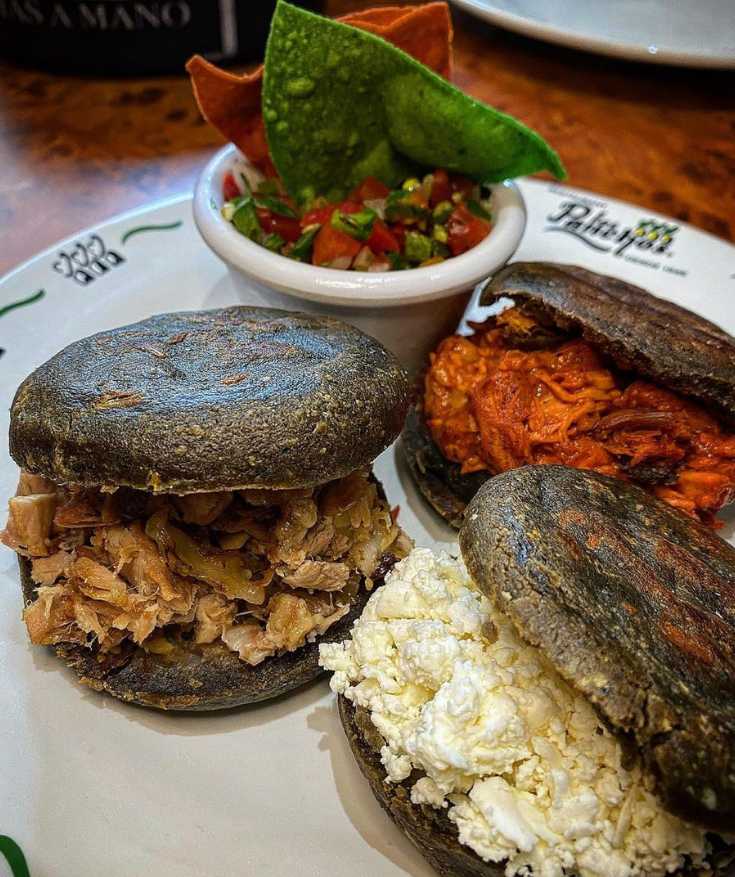

As time went on, gorditas became more popular and started appearing on menus at street food stands and restaurants across Mexico.
One fun fact about gorditas is that they can vary greatly depending on where you are in Mexico. In some regions, they are fried until crispy, while others prefer them soft and fluffy.
Arroz con leche
Arroz con leche, or rice pudding, is a beloved dessert in Mexico that has been enjoyed for generations. This creamy and sweet treat is made from rice cooked in milk with cinnamon and sugar, creating a comforting dish that warms the soul. But where did this delicious dessert come from?


The history of arroz con leche dates back to ancient times when rice was first introduced to Mexico by Spanish colonizers. Over time, the dish evolved into its current form as Mexican chefs added their own unique flavors and ingredients.
Today, arroz con leche is a staple at family gatherings, parties, and celebrations throughout Mexico. In some regions of Mexico, arroz con leche is traditionally served as breakfast rather than dessert! It’s also common to add raisins or other fruits such as strawberries or mangoes for an extra burst of flavor.
Empanadas
If you’re a foodie looking for an adventure in Mexico, you can’t miss out on empanadas! These delicious pockets of dough stuffed with various ingredients are a popular street food all over the country. But do you know how they came to be?


Empanadas have a long history in Mexico and beyond. They were originally brought to Latin America by Spanish colonizers in the 16th century, who were influenced by Middle Eastern cuisine. However, each region has its own unique take on the beloved dish.
In Mexico, they are typically made with corn masa (dough) and filled with meats like shredded chicken or beef, as well as cheese and vegetables such as potato or squash.
Marquesitas
Marquesitas are one of the most beloved street foods in Mexico. This delicious dessert is a must-try for anyone visiting the country, and it has an interesting history that dates back to the 1940s.
According to legend, marquesitas were created by a street vendor named Marquesa who wanted to offer something new and delicious to her customers. She combined traditional Mexican flavors with European-style crepes, creating a sweet treat that quickly became a hit.


Today, marquesitas are sold all over Mexico and have become an iconic part of the country’s culinary culture.
One of the fun things about marquesitas is that they can be customized with endless fillings and toppings. Some popular options include Nutella, condensed milk, chocolate chips, cheese, fruits like strawberries or bananas, and even savory ingredients like ham or bacon.
⁉️ Mexican food FAQ
What are popular Mexican foods?
Mexican cuisine is renowned all over the world for its vibrant flavors, fresh ingredients, and diverse range of dishes. From tacos and burritos, to tamales and pozole, Mexican cuisine has something for everyone. One of the most iconic dishes in Mexican cuisine is the taco.
Tacos consist of a soft or hard tortilla, filled with various delicious ingredients such as beef, pork, chicken, or fish, and topped with salsa and other garnishes. They are a versatile and portable food perfect for a quick bite on the go or as a full meal.
Another popular Mexican food is enchiladas. These are tortillas filled with meat, cheese or beans, and smothered in chili sauce.
Enchiladas are often served with rice and refried beans, and topped with sour cream or guacamole. They are a hearty and comforting dishes that can be customized with a variety of fillings and sauces to suit individual tastes.


Guacamole is another favorite Mexican dish, which is a dip made with mashed avocado, lime juice, garlic, and chopped tomatoes and onions. It is a perfect snack to share with friends, and can be served alongside tortilla chips or as a condiment for tacos and other dishes. Its creamy texture and fresh flavors make it a perfect addition to any meal.
Chiles Rellenos are stuffed poblano peppers filled with cheese, minced meat or seafood. The peppers are usually roasted and peeled and then stuffed with a filling, battered and deep-fried. They are served with tomato sauce and rice, making for an impressive and delicious meal that can be served for lunch or dinner.
Mexican cuisine also has a rich tradition of soups and stews, with Pozole being one of the most popular. Pozole is a hearty and spicy soup made with hominy, meat (usually pork), and chili peppers.
It is often served with shredded cabbage, lime wedges, and diced onions, making for a flavorful and satisfying meal that can warm you up on a cold day.
These are just a few examples of the many delicious and popular Mexican foods that are enjoyed all over the world. The vibrant flavors, fresh ingredients, and diverse dishes make Mexican cuisine a true culinary delight!
What are 5 traditional foods in Mexico?
Mexican cuisine is known for its colorful and flavorful dishes that use ingredients like chili peppers, corn, and beans as staples. Here are five traditional foods that you can find in Mexico:
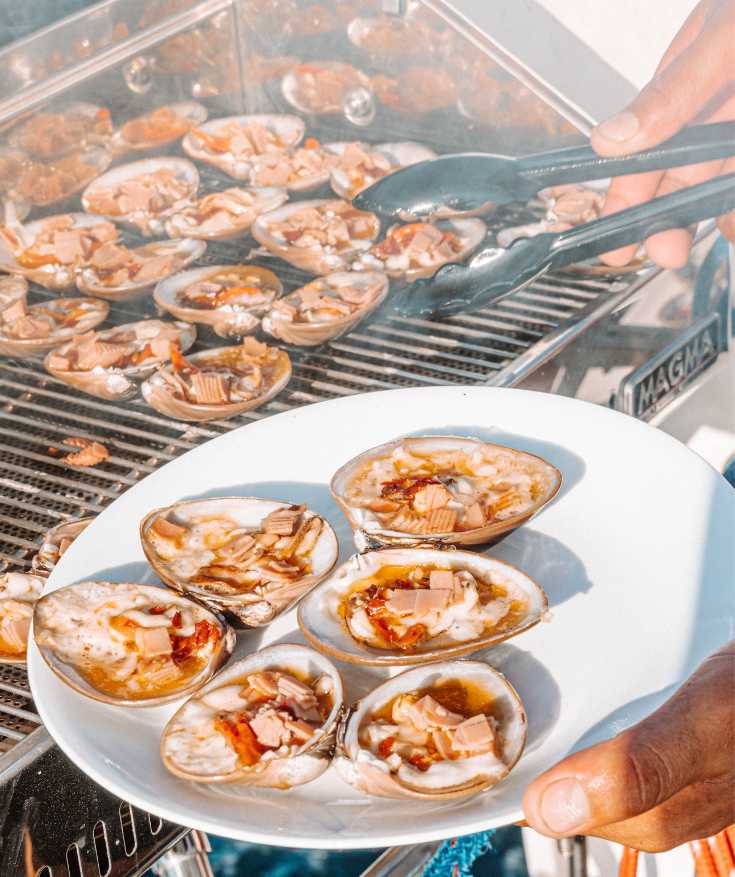

- Tamales: Tamales are a traditional Mexican food made with a masa dough (a dough made from corn) that is filled with various ingredients like meat, beans, cheese, or vegetables, and then steamed in a corn husk. They are often served with salsa or guacamole and are a popular dish during the holiday season and other special occasions.
- Chiles Rellenos: Chiles Rellenos are a classic Mexican dish where pepper (usually poblano peppers) are stuffed with cheese, meat or seafood, and then battered and fried until crispy on the outside. They are typically served with a tomato sauce and rice, and are popular in central and southern regions of Mexico.
- Mole: Mole is a complex sauce made with a blend of chili peppers, spices, nuts, seeds, and chocolate. The sauce is used to flavor a variety of dishes, including chicken, pork, or beef. Mole can take many hours to make and is a quintessential part of Mexican cuisine.
- Pozole: Pozole is a soup that is made with hominy (a type of corn), meat (usually pork) and chili peppers. It is often garnished with shredded lettuce, radishes, onion, and lime juice. Pozole is a dish that is popular during special occasions or celebrations and can be found in restaurants and street vendors.
- Barbacoa: Barbacoa is a traditional method of cooking meat that is slow-cooked in a pit with leaves (usually banana or avocado) that add an earthy flavor. The most common meat used in barbacoa is lamb, but beef and pork are also used. Barbacoa is often served with tortillas, cilantro, and onions.
These five dishes are just a few examples of the many popular traditional foods in Mexico. The use of fresh ingredients and bold flavors make Mexican cuisine appealing to people around the world.
What is traditional Mexican food?
Traditional Mexican food is famous for its bold and vibrant flavors, striking colors and a great variety of ingredients. Mexican cuisine has deep roots in pre-Hispanic culinary techniques and ingredients, which have infused modern-day cuisine with unique qualities.
Corn is a staple ingredient in many traditional Mexican dishes, and it forms the base for tortillas, an essential element of many dishes. A classic Mexican meal usually consists of rice, beans, tortillas, and meat, served with a range of sauces and toppings.
Mexican cuisine is rich and diverse, with many unique flavors and dishes that vary depending on the region.
For example, the cuisine of the Yucatan Peninsula is heavily influenced by Mayan traditions, while the cuisine of Oaxaca is known for its moles, or rich chili sauces made with a variety of ingredients, including nuts, seeds, and chocolate.
In addition to moles, salsas are an essential component of Mexican cuisine. They are made with a blend of chili peppers, tomatoes, onion, and other spices and are used to flavor a variety of dishes or as a condiment served on the table.


Guacamole is also very popular, which is a dip made from mashed avocado and a combination of spices and herbs.
Meat, particularly beef and pork, is common in many Mexican dishes, although chicken and seafood are also popular. The meat is often seasoned with a combination of spices and cooked over an open flame or in a hot skillet, which adds depth and richness to the dish.
Vegetables like onions, garlic, and peppers are also used extensively in Mexican cuisine as they add flavor and texture to dishes.
Overall, traditional Mexican food is colorful, flavorful, and exciting. From tacos and enchiladas to mole and barbacoa, the cuisine offers various delicious dishes steeped in history and culinary traditions.
Combining fresh ingredients, bold flavors, and unique cooking techniques makes Mexican cuisine a true culinary delight that appeals to people worldwide.
What is the most known Mexican food?
Tacos are probably the most well-known and iconic Mexican food around the world. They consist of a tortilla filled with various ingredients, such as beef, pork, chicken, or fish, and topped with a selection of garnishes, such as salsa, lettuce, cheese, and guacamole.
The combination of fresh ingredients, bold flavors, and endless variations has made tacos popular not just in Mexico, but worldwide, with many restaurants dedicated solely to serving this dish.
Another popular Mexican dish that is known worldwide is Guacamole. It’s a dip made from mashed avocado, lime juice, tomatoes, onions, and seasonings. It is often served with tortilla chips, used as a condiment for tacos or tostadas, or as a side dish to complement other Mexican entrees.
The creamy texture and fresh, citrusy flavor of guacamole make it a perfect complement to many other Mexican dishes.
Enchiladas are also a classic Mexican dish that has gained popularity around the world. They are made by filling tortillas with meat, cheese, beans, or vegetables and rolling them up.


The rolls are then smothered in sauce, typically red or green chili sauce, and topped with cheese and baked. Enchiladas are often served with rice, refried beans or a side salad, and are a popular food for celebrations or family gatherings.
Chiles Rellenos is another popular Mexican dish that has gained popularity across the globe. It consists of a stuffed poblano pepper that is often filled with cheese, minced meat, or seafood.
The pepper is then battered, fried, and served with tomato sauce and rice. Its crispy exterior and often cheese-filled interior make it a popular dish, especially for those who prefer milder heat to their meals.
Finally, we cannot forget to mention Burritos- a popular Mexican dish that is now popular all around the world. They are made of a flour tortilla filled with ingredients like beans, cheese, rice, and meat, which are then wrapped into a cylinder shape.
Burritos are often topped with salsa, cheese, and guacamole, and are often served as a large and filling meal.
Mexican cuisine offers many dishes rich in flavor and cultural history. These are just a few examples of the many popular Mexican dishes enjoyed worldwide, but the range of Mexican foods is vast, offering something for everyone’s palate.
What is Mexico’s unique food?
One of the most unique and traditional Mexican foods is Mole. This dish originated in the southern state of Oaxaca and is made from chili peppers, spices, nuts, and chocolate to form a sauce. This sauce is then poured over chicken or pork and served with rice, beans, or tortillas.
The dish has so many variations that trying them all can be a cultural and culinary experience.
Another unique Mexican food is Tamales, made with a masa dough and often stuffed with meat, cheese, or vegetables. They are steamed or boiled and can be found in many different forms throughout Mexico. The traditional way of serving them is with a sauce and, in some cases, sprinkled with cheese or other toppings.
Ceviche is a seafood dish originating from the coastal regions of Mexico. It is made of raw fish marinated in lime juice, mixed with vegetables and chili peppers, and served in a small bowl. The acidity of the lime juice “cooks” the fish, making it safe to eat.


This dish is fresh, flavorful, and unique, and a popular choice for a refreshing lunch or light dinner.
Finally, Mexico is famous for its selection of salsas made from a blend of chili peppers, tomatoes, onions, garlic, and other spices. Salsas vary widely in flavor depending on the type of chili pepper used, and they range from mild to extremely spicy.
Salsas are often served alongside other dishes to add an extra kick to the flavor, and they can become an experience in itself to try them all.
These foods are just a few examples of the unique and diverse cuisine that defines Mexican food heritage. Plenty of other dishes are just as characteristic of Mexico’s unique cuisine, showcasing a range of flavors and ingredients that are difficult to find anywhere else in the world.
What is the most basic food in Mexico?
One of the most basic ingredients used in Mexican cooking is corn. This grain is used to make several dishes including tortillas, tamales, and elotes (corn on the cob). Corn has been a staple of Mexican diets for centuries and many regional dishes are based around this ingredient.
Beans are also an essential part of Mexican cooking with frijoles (beans) being used as both a side dish or filler for tacos or burritos. Traditionally Mexicans would use dried beans though today canned beans can be found in many markets across Mexico.
Beans provide an inexpensive protein source while adding flavor and texture to food.


Rice is another very common staple in Mexican cuisine. It’s often served alongside main dishes such as stews or braised meats and adds body to soups and salads. In particular, red rice is particularly popular in Mexico due to its more intense flavor profile compared to white rice.
Finally, cheese is one of Mexico’s oldest sources of nutrition, dating back centuries before European explorers arrived in the region. Cheese plays an important role in Mexican cooking as a topping on tacos or quesadillas or stuffed into enchiladas or burritos.
Some regions even have their own traditional cheese-based dishes such as queso fundido from Puebla or panela from Oaxaca that are unique to specific areas.
These four basic ingredients form part of the foundation upon which much of Mexican cooking is based upon; with them you can create a great variety of both simple yet flavorful recipes using fresh produce that brings out bold flavors from these staples like no other cuisine does quite like Mexico does!
What is a typical Mexican dinner?
A typical Mexican dinner combines traditional dishes, flavors, and ingredients that have been carefully passed down through generations. Whether in a small rural village or a cosmopolitan city, the food served at dinnertime is an integral part of the culture and heritage of Mexico.
A typical Mexican dinner begins with snacks such as chips, salsa, or guacamole to provide longer sustenance. This is usually followed by a main dish such as tacos, enchiladas, chiles rellenos, tamales, or quesadillas.
Rice and refried beans are often served alongside these meals, while other side dishes like vegetables or salads may also be present depending on the region and preference.


Various sauces and condiments generally accompany dinner to enhance the flavor; these can range from mild to very spicy, depending on the individual’s taste.
Various fresh fruits, including oranges, melons, mangos, papayas, and pineapples, are often eaten for dessert afterward. Drinks typical for Mexican dinners include soft drinks or agua frescas made with fruit juice with sugar added.
Overall, a typical Mexican dinner provides not only great flavor but also has cultural significance and represents centuries-old traditions that have been practiced for many generations inside Mexico and worldwide.
What do Mexicans eat daily?
Mexicans have a diet based on traditional foods with ingredients and flavors passed down through generations. The diet can vary throughout the country depending upon the region and individual preferences, but some staples are eaten daily in most households.
A typical Mexican breakfast usually consists of eggs and beans served with warm tortillas; sometimes, this is accompanied by rice or a type of Mexican-style sausage such as chorizo. It might include various dishes from enfrijoladas to huevos rancheros.
Lunch typically consists of both carbohydrates, proteins, and vegetables and usually has something for everyone, including tacos, soups, stews, salads, tamales and much more.


Common accompaniments for lunch include refried beans, guacamole, salsa or sour cream; these are all great sources of nutrients and vitamins that provide energy for the day ahead.
The midday meal is also important as it provides sustenance during siesta time, a popular part of Mexican culture where people take naps after lunch before continuing work.
Dinner follows in the evening which is often served later than other cultures due to Mexico’s warmer climates which means it doesn’t get dark until much later in the evening.
Overall Mexicans have an array of options when it comes to their daily meals that provide them with all the sustenance they need while also being flavorful, colorful and exciting!
🇲🇽 Mexico Travel Resources
- Best cheap flights finder: Kiwi.com
- Best travel insurance: Ekta Traveling
- Best rental car deals: Discover Cars
- Best accommodations platform: Booking.com
- Best activities and tours: Mexico Insider Tours



